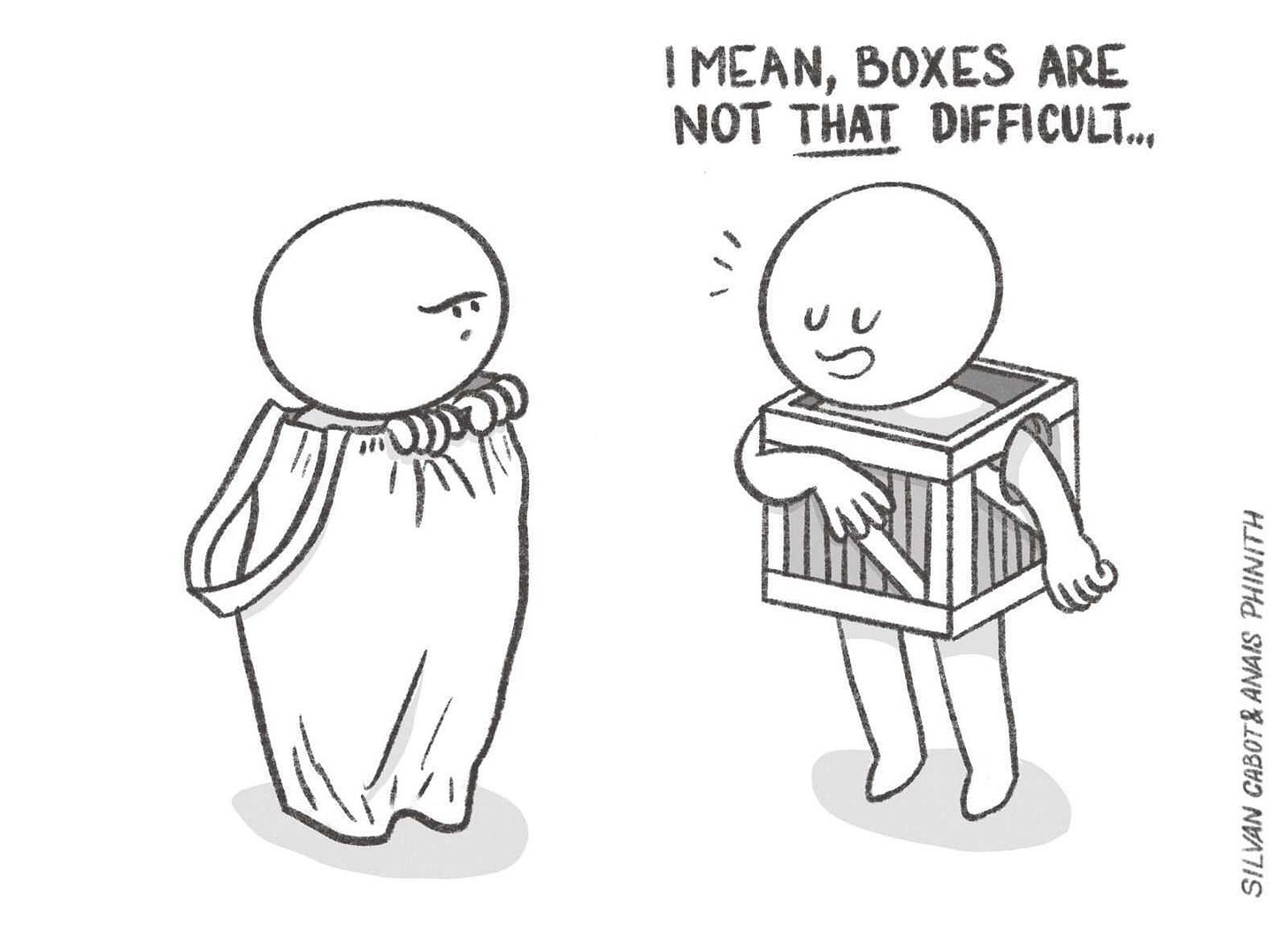Getting the best of bags and boxes
By now, you should be familiar with the concept of Bags and Boxes.
I’ve explained it in my previous newsletters: Bags are flexible practices teams can own, shape, and share, while Boxes are non-negotiable practices that must be consistent across teams.
But when it’s time to put this into practice, it’s easy to get it wrong. They create a few rules, slap labels on them, and call it done. This results in friction, mistrust, and confusion.
If you want to implement Bags and Boxes properly, here’s what it actually takes.
MUST - Do These or Don’t Bother
This is your foundation. If these five things aren’t in place, don’t expect the rest of the system to hold.
1. Start with leadership
If leadership doesn’t understand the Bags and Boxes principles, the system is doomed from the start.
So start with them, get full alignment, and create the Box roadmap together. The most important step is to sort the current best practices with them, so they take ownership from day one.
If they’re not actively involved, expect resistance later.
2. Invest in solid bagshelves
As I explained previously, bagshelves are how teams see and access each other’s Bags.
Make sure teams can document and share their best practices easily. Give them space, rituals, and support to do it. That could be dedicated meetings, open forums, or anything else that works. Whatever the format, the rules are simple: Bags need to be easy to communicate, easy to find, and supported across teams.
The more Bags are embedded in daily work, the more trust you’ll earn in your Boxes.
3. Create clear governance
This is where most companies stumble.
Leadership should own the Boxes, but the day-to-day management should be done by a small, dedicated team. It could be ops, coaches, HR… the department is not important, as long as someone is has dedicated time for it.
The same team should maintain the bagshelf, guaranteeing that Bags are shared, reusable, and compliant with existing Boxes.
As for Bags? Teams own and manage them, no debate here.
4. Involve teams in the Boxes
Boxes are owned by leadership, but they shouldn’t be created in isolation.
Bring teams into the process, interview them like you would your users, explore their pain points, prototype and experiment. If teams are expected to follow the Boxes, they should have a hand in shaping them. Otherwise, good luck getting adoption.
Treat your Boxes like you’d treat your product. You already know how to do discovery, so use those skills here.
5. Remember who this is for
The whole point of Bags and Boxes is to support teams.
If the system becomes a burden, change it. You’re not building doctrine, you’re building the grounds for better collaboration.
SHOULD - Strong Moves That Set You Up for Success
These best practices aren’t mandatory, but they’ll make everything easier.
1. Start where you are
Most likely, your organization already has rules that can easily become Boxes.
Similarly, you have teams who’d happily share their practices on one or more topics. That’s your starting point for Bags.
I’m usually not a fan of quick wins because, in most cases, they prevent deeper improvements. But this is the exception. Here, quick wins help show the system works, while building both the mechanism and the mindset.
2. Invest massively in Bags, early on
Your first priority is traction.
Teams need to understand the Bags mechanism and embrace it. You can kick things off with a giant open forum, or dedicated trainings, for example, as long as it gets people involved.
The mechanism matters more than the destination. And remember: the quality of your bagshelves will directly impact the strength of your Boxes.
3. Create a roadmap for Boxes
Don’t just drop Boxes out of nowhere.
Make your priorities visible, and tell teams what’s coming and why.
But don’t try to implement everything at the same time. Boxes are an investment and take time. Don’t “half build” one and expect it to work.
4. Design Bags and Boxes in parallel
Leaders tend to focus on Boxes and ignore the Bags. That’s a mistake.
Bags are not second-class citizens, they’re what builds the trust needed for Boxes to work.
If you want adoption and long-term scale, support both.
5. Define outcomes for each Box
Don’t just say “everyone must do X.”
Track the result. What’s the point of the Box? What behavior should it drive? Measure it and make the dashboard visible to everyone.
If a Box isn’t working, you’ll want to know fast.
COULD - Experiment Your Path to Success
This section is yours.
Once you’ve got the foundation in place, everything else is a Could: your bag templates, your box documentation, your workshops, anything.
There are a million possibilities, and none of them work everywhere.
So experiment, adapt, and evolve.
If you’re still hoping for a one-size-fits-all framework… you missed the point of Bags and Boxes entirely.
DON’T - What You Must Never Do
These are not best practices. They’re traps. And they’ll undermine the system from the inside.
1. A Bag should never contradict a Box
No exceptions. The moment this happens, trust breaks.
If people see conflicting rules, they’ll stop trusting the Boxes entirely.
2. Don’t try to turn every good practice into a Box
Take retrospectives: they’re a great ritual and useful for every team. But that doesn’t turn them into a Box, they’re still a Bag!
Boxes are limited to best practices that would negatively impact other teams if not followed.
3. Don’t pretend there are quick wins with Boxes
Every Box comes with a price tag: testing, documentation, training.
If you’re not willing to pay the price, don’t even make the rule. Otherwise, your teams will ignore it (and rightly so).
4. Never create “local Boxes”
This one’s tricky but important.
Every manager wants Bags from their boss (freedom) and Boxes for their team (control). Don’t let that happen. If something’s a Box, it’s a Box for everyone. If it doesn’t scale organization-wide, it shouldn’t be a Box at all.
There may be exceptions for regulatory reasons, but even then, describe exactly which teams are impacted and why. “Because this team reports to X” is not a valid reason.
5. Popular ≠ Mandatory
Even if a Bag is used by every single team in your company, that doesn’t mean it should become a Box.
It might be a great Bag! But teams need to be able to experiment with it, change it, and improve it. If you turn it into a Box, it becomes locked and closed for iteration.
The goal of Bags and Boxes is to create enough structure that teams can move fast without stepping on each other, but not so much that innovation gets strangled by rules.
If you build the system with the right foundations, and if you resist the urge to overcontrol, it can become a powerful way to scale good practices, without killing what made them work in the first place.
Are you trying to implement Bags and Boxes in your organization, but struggling to do it? Feel free to message me, I’d be happy to help!




